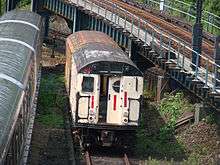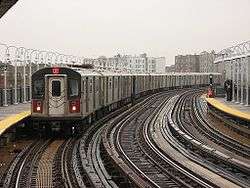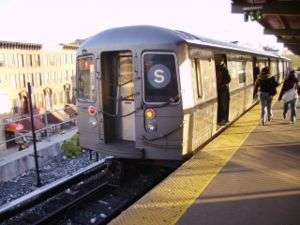R17 (New York City Subway car)
| R17 | |
|---|---|
|
R17 car 6609 on display at the New York Transit Museum. | |
|
Interior of an R17 car at the NYTM. | |
| In service | 1954-1988 |
| Manufacturer | St. Louis Car Company |
| Built at | St. Louis, Missouri |
| Constructed | 1954-1956 |
| Number built | 400 |
| Number in service | (4 in work service) |
| Number preserved | 2 |
| Number scrapped | 393 (+1 in storage) |
| Fleet numbers | 6500-6899 |
| Capacity | 44 (seated) |
| Operator(s) | New York City Transit Authority |
| Specifications | |
| Car body construction | LAHT Carbon steel |
| Car length | 51 ft 0 1⁄2 in (15.56 m) |
| Width | 8 ft 10 3⁄16 in (2,697 mm) |
| Height | 11 ft 10 in (3,607 mm) |
| Floor height | 3 ft 9 in (1.14 m) |
| Doors | 6 |
| Maximum speed | 55 mph (89 km/h) |
| Weight |
General Electric cars: 77,887 lb (35,329 kg) Westinghouse cars: 79,193 lb (35,921 kg) |
| Traction system |
General Electric cars: GE MCM 17KG137D1, with 17KC76A1 master controller, using GE 1240-A4 motors (100 hp per axle). 4 motors per car (2 per truck). Westinghouse cars: WH Unit Switch UPC-631B, with XM-179 master controller, using WH 1447C motors (100 hp per axle). 4 motors per car (2 per truck). Air Compressor: WABCO 2-C-Y |
| Power output | 100 hp (75 kW) per traction motor |
| Electric system(s) | 600 V DC Third rail |
| Current collection method | Top running Contact shoe |
| Braking system(s) | WABCO Schedule SMEE with A-1 Application package, J1 relay valve, ME-42A brake stand, and A.S.F simplex unit cylinder clasp brake rigging |
| Coupling system | WABCO H2C |
| Track gauge | 4 ft 8 1⁄2 in (1,435 mm) |
The R17 was a New York City Subway car class built in 1954 by the St. Louis Car Company.
Description
The R17s were numbered 6500-6899.
The R17s were one of three car classes purchased in the mid-1950s by the New York City Transit Authority to replace much of the pre-World War II IRT High Voltage (Hi-V) rolling stock, which included the Gibbs cars, the Deck Roofs, and the Hedley Hi-V cars.
The R17s were single unit cars capable of operating both independently or as part of a longer train.
There were two versions of the R17: General Electric-powered cars (6500-6699) and Westinghouse Electric-powered cars (6700-6899).[1]
Cars 6800-6809 were factory equipped air conditioning when delivered.[2] However, the air conditioning experiment was considered a failure, and the cars were refitted with standard axiflow fans between 1962 and 1964.

As delivered, R17s came with low-running lights and very comfortable foam rubber seats. In 1957, sealed beam headlights were added to the cars. Additionally, vandalism and wear & tear contributed to rapid and frequent damage to the original seats, leading the Transit Authority to replace the seats with hard fiberglass benches similar in feel to the ones in use on New York City subway trains today.
While the cars received the fox red paint scheme like other cars that would go on to be later known as "Redbirds," that nickname was never given to these cars. The only nickname for the R17s was given to the GE-powered cars by shop and operating personnel: "Flat bottoms." The name was derived from the large box underneath the car that contained the switch group, resistor grids, and other propulsion control electrical equipment. Designed to simplify maintenance, in practice the heavy box proved unwieldy. Resistance grids also generate a good deal of heat, and therefore need to be cooled. Typically this is done automatically on a subway car that uses a DC propulsion system, as the grids are exposed and the train's natural movement creates a breeze that ventilates and cools the grids. But since the R17's grids were enclosed in the heavy box, ventilation and cooling would be provided by using the spinning rotor of the Motor-generator to act as a fan feeding air into the box. The GE R17s were not the only subway cars with this arrangement. The GE-powered R16s had a similar setup, and therefore the "Flat bottom" nickname applies to the GE cars in that class as well for the same reason as above. The nickname never applied to the Westinghouse cars in either class.
The major identifying characteristics of the R17 can all be found in its windows. These include the circular windows on the car end doors, similar to those found on the R15 and the B Division R11 and R16. The R17 also features large, rounded rectangle windows on its side doors, similar to those found on nearly every car in today's subway system. While similar to the R16 in outward appearance, as an A Division car, it is smaller and contains only three doors on each side of the car (instead of four). Side windows are of a two-pane, pull-down drop sash type (used until the Main Line R36s).
The R17, like many older New York City Subway cars built for the A Division, also features two sets of mid-carbody passenger windows on each side. Normally arranged in two pairs of three on the R15, on the R17 one set of windows on each side contains a rollsign in lieu of a third window. The sign contains three readings arranged vertically on its box - the top two being the train's terminals, and the bottom being the train's route. This window and signbox pattern, first appearing on the R16 became the blueprint for the later R21 and R22, the Redbirds, and even influenced the design of trains still in service today. The R32 fleet uses a similar rollsign design to that first found on the R16.
History
The first train of R17s was placed in service on the 6 train on October 10, 1955. All 400 cars were delivered by January 1956.
The R17s were delivered in a maroon paint scheme. Some were repainted bright red ("tartar red") in the late 1960s. All cars received the TA platinum mist/blue paint job starting in 1970. In the early 1980s, they were painted plain white and eventually 16 cars were repainted fox red for 42nd Street Shuttle service in 1985-86. All 16 of the fox red cars were sent to the Flushing Line to fill in for the R33 singles while they were being overhauled. The red R17s were the last to remain in service, running on the 5 train and being mixed with both rebuilt and unrebuilt R26-R33 cars.[3]
During the course of their careers, two cars (6673 and 6786) were wrecked in 1957 as a result of a collision near Zerega Avenue, and three cars (6595, 6597, and 6601) were destroyed by fire - at the 42nd Street Shuttle fire at Grand Central in 1964.
Retirement

The R17s were replaced by the R62As as they had reached the end of their planned service lives. The final train of R17s ran on February 29, 1988 (as a solid consist of R17s) in 5 train service.
The majority of the remainder of the fleet was scrapped, although some R17 cars have been set aside for preservation over the years. These include:
- Car 6609, restored in 1976 and displayed at the New York Transit Museum in Brooklyn. It is fully operational and runs periodically on museum sponsored "Nostalgia Trains."
- Car 6688, preserved at the Shore Line Trolley Museum in East Haven, Connecticut. It is fully operational and runs frequently during the summer months for rapid transit themed programming.
As of 2016, four other R17s survive as work cars.
- Cars 6813 and 6850, converted to R123 continuous welded rail holder cars for set DCR and overhauled under the R128 program.[4]
- Cars 6835 and 6899, converted to R71 hose reach cars and overhauled under the R159 program.[5]
Car 6895 is currently in storage at Concourse Yard with R21 716, and has not moved since 2002. This car is still classified as a work car and was used on a special trip sometime during the 1990s. Although it was reported that the cars may be operational and preserved, the car was stripped of parts in 2009 (such as sash windows and roll signs). As of June 2016, both cars are still there, possibly awaiting scrap.[6]
Car 6762 was converted to an R71 rider car after retirement, but was replaced with R161s (R33s converted into rider cars) in the mid-2000s and eventually reefed.[7]
The R17 in cinema
Cars 6671 and 6609 were featured at Grand Central Terminal in the 1971 film The French Connection in a scene where Gene Hackman's character is tailing a heroin smuggler. At that time, the cars were painted in the MTA platinum mist/blue band livery.
R17s can been seen on the 42nd Street Shuttle in Ron Howard's Night Shift (1982).
White painted (though clean) R17s on the Shuttle appear in a scene of Mike Nichols' Heartburn (1986) with Meryl Streep and Kevin Spacey, with cars 6699 and 6550. The shuttle platform at Grand Central was doubling for the Christopher Street Station on the 1.
The interior of a repainted red R17 operating on the 5 train can be briefly seen in the opening credits of Oliver Stone's Wall Street (1987).
Car 6688, which belongs to the Shore Line Trolley Museum, appears in the 2014 film The Amazing Spider-Man 2.
References
- ↑ Gene Sansone, New York Subways: An Illustrated History of New York City's Transit Cars, ISBN 0-8018-6886-6, pp. 203 - 210
- ↑ Sass), Ralph Katzthe New York Times (by Fred J. (1956-07-10). "6 AIR-COOLED CARS ARE TESTED ON IRT; Transit Authority Shows the Subway of the Future". The New York Times. ISSN 0362-4331. Retrieved 2016-06-20.
- ↑ "Showing Image 114716". nycsubway.org.
- ↑ http://www.nycsubway.org/wiki/R-123_Continuous_Welded_Rail_Cars
- ↑ http://www.nycsubway.org/wiki/R-71_Reach_Cars
- ↑ R17 in Concourse Yard http://nycsubway.org/perl/show?57790
- ↑ http://nycsubway.org/wiki/R-71_Rider_Cars



